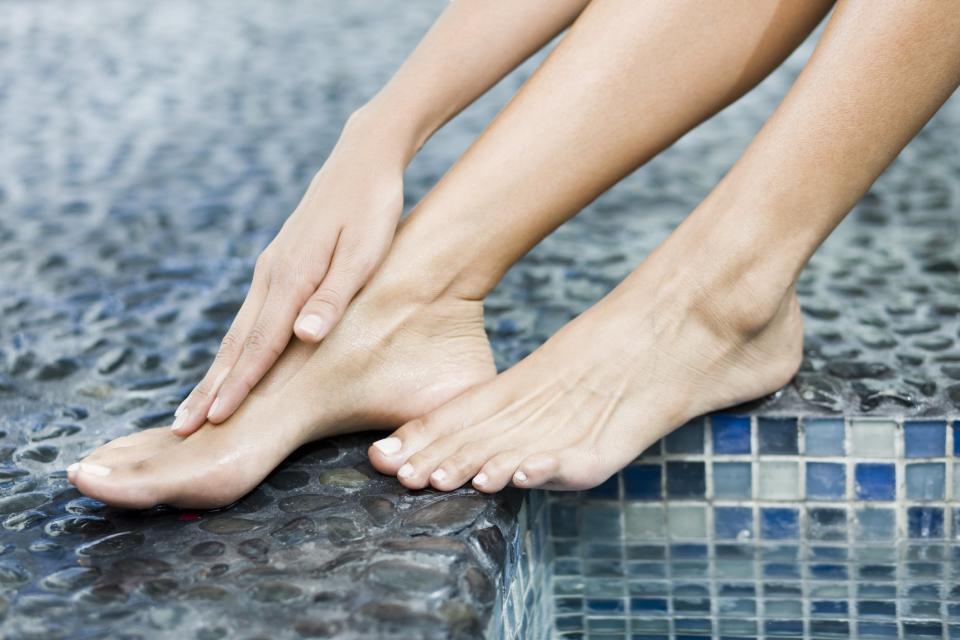The Heel-to-Toe Guide to Healthy Feet
They get you everywhere you need to go while showing off your favorite shoes and perfect pedicure. You probably take your feet for granted; they don’t get much attention until they’re sore or aching, and then all we do is complain. Stop mistreating your feet! Here’s what you need to know to save your soles, heal your heels, and tend to your toes.

1. Banish blisters. Blisters are the fastest way to make you resent your brand-new shoes. But Dr. Tsippora Shainhouse, MD, FAAD, a board-certified dermatologist in Santa Monica, CA, and clinical instructor at the University of Southern California, reassures us that there are a few things you can do to avoid that pain. “When you try on shoes, if you feel the sides rubbing anywhere, especially your baby toes, don’t buy them,” she advises. “Choose breathable materials, like leather and canvas, and wear nylon socks that wick away wetness. If you can’t wear socks, apply a barrier like Vaseline, baby powder, or special foot balms to areas that might rub before you put on your shoes.” No more silent seething at your new heels 30 minutes into happy hour.
2. Heal your heel pain. The most common cause of pain under the heel is plantar fasciitis, which affects one in 10 people in their lifetime. It’s an inflammation of the plantar fascia, the band of tissue that runs along the sole of your foot between your heel and toes. Dr. Barbara Bergin, MD, founder of Texas Orthopedics, Sports & Rehabilitation Associates in Austin, TX, describes it as, “pain on the bottom of your foot, right in front of the heel, toward the arch. It is usually worse when you get out of bed in the morning, or when you stand up after sitting for a while.”
Fortunately, this condition is usually easily treatable with stretching. Sometimes, says Bergin, if you can get past the initial pain, just walking around will help stretch out the plantar fascia enough to stop it from hurting. California-based podiatrist Dr. Samira Mehrizi, DPM, has another homemade remedy that will get you odd looks in the office: “Roll a tennis ball or ice water bottle across the bottom of your foot. And stretch your calf muscles.”
3. Treat your toenails. Ingrown toenails are another common problem — but you might not even notice them for a while. “The pain can be subtle at first,” says Bergin, “but ignoring it and cutting the toenail even shorter results in overgrowth of the soft flesh on the inside of the toe. The flesh presses in over the growing nail, causing it to dig in to your toe, eventually resulting in an infection.” Ouch. To cure it, she advises, “Stop wearing close-toed shoes for a while, if you can, and don’t be tempted to clip your toenail short. See your podiatrist or orthopedic surgeon for treatment, before a deep infection develops.” Sandals it is.
4. Bust bunions. Bunions are deformities that occur when pressure on the base of the big toe forces the bone to push against the first metatarsal, forming a painful bump on the side of your foot. You’ve probably seen photos of female celebrities with them, because they are exacerbated by wearing high heels. But heels don’t cause bunions: Blame your genes. “It’s not the condition we inherit but the shape of our feet,” explains Dr. Alice Holland, DPT, director of Stride Strong Physical Therapy in Portland, OR. “Bunions actually don’t tend to run in the family; wide feet do. Bunions are the result of wide feet being squeezed into very narrow footwear — either pointy men’s dress shoes or women’s high heels.”
If you’re in a family of wide-footed bunion sufferers, there are ways to limit their impact. In addition to giving up your tight, high heels, Mehrizi recommends getting custom orthotics. Do this and you’ll likely be able to avoid surgery, which is recommended only if your bunions have deformed your feet and/or are interfering with your ability to walk. “Bunion surgery entails realigning the head of the metatarsal back to its original state, which requires cutting bone, moving it over to the appropriate position, and fixing it in place with a screw,” Mehrizi explains. “The surgery is usually covered by insurance, but if not, it can cost anywhere from $5,000 [and up], depending on how bad the bunion is.” Those Louboutins might not be worth it, after all.
5. Shop smart. High heels aren’t the only target of podiatrists’ wrath. All of them recommended looking for a wider toe box when shopping for new shoes. “Unfortunately, most shoes are not made for real feet that are wider in front and narrow at the heel,” laments Dr. Ernest L. Isaacson, DPM, New York City-based board-certified podiatrist. The best time for finding shoes that fit, he says, is at the end of the day. “That’s when feet are a little more swollen, so you can make sure there’s a generous amount of room for your toes. Also remember that toes spread out when bearing weight, and your shoes should accommodate that,” he advises. Don’t panic — not all heels are banned. “Heels are a more natural position for most feet: 1.5-inch to two-inch is the sweet spot,” he says.
When you’re at home, the best shoes are no shoes. “The number one thing we should do for our feet is walk barefoot in our houses,” Holland recommends. “This allows the toes to stretch and gives feet freedom to move so the muscles get stronger. Keeping feet cramped in shoes all day weakens them over time.” So slip off your high heels, kick back, and free your feet!
Will you be switching to low heels? Let us know how you keep your feet happy @BritandCo.
(Photo via Getty)


